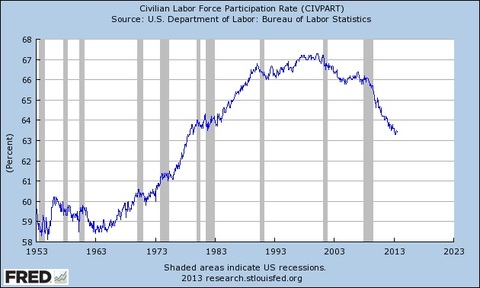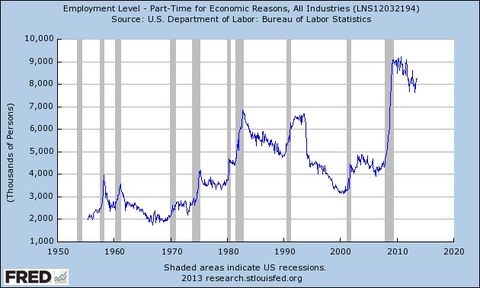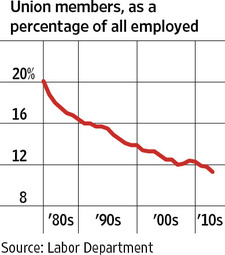Part Time America
Part Time America
Weekly Market Commentary 8-5-2013
Tim Phillips, CEO—Phillips & Company
I have written on many occasions about the possibility of a structural change in the American workforce.
Work is the bedrock of our economy. With over 71% of GDP generated by consumption, how we get our money matters. There is much more than a casual linkage between work, wages and consumption.
First, wages as a percent of GDP use to be over 51% of GDP. It now sits at roughly 43%, which is near an all-time low.

(Image source: Federal Reserve)
Second, the percent of people participating in the workforce is also at a low not seen in decades.[i]

(Image source: Federal Reserve)
Finally, and most troubling, is the boom in part-time employment for economic reasons. In the current jobs report, part-time workers increased to 8.25 million.[ii] Part-time work accounted for more than 65 percent of the positions employers added in July[iii].

(Image source: Federal Reserve)
While there is a slight improvement since the financial crisis, it's disturbingly high. Low-paying retailers, restaurants and bars supplied more than 40 percent of July's job gains.[iv]

Over the long-run (5 years or more) it's difficult to make the case for growing consumption without more people being put to work full time.
One cause of the boom in part-time employment is the concern over Obamacare. Employers with fewer than 50 employees have a direct incentive to not cross that threshold due to penalties associated with not-providing health care or being forced to provide coverage.
Since the Census Bureau does not specifically list companies with 50 employees or fewer, we can estimate that number to be 5.6 million, out of 5.9 million total employer firms.[v]
That's 26.31% of all employees and 93.73% of all firms. This is no small matter.
Another likely cause is companies want to maintain profit margins, and hiring full-time workers without a clear pick-up in demand does not fulfill that mandate.
A flexible workforce (code for part-time workers) is a much better proposition for those that own companies versus those that don't. You can simply look at union membership to see how expensive labor is doing in our country.[vi]

In any case, part-time employment is a trend worth watching and reacting to accordingly. As an investor, in the short-run, profit margins should continue to prosper. This is good news.
The problem is the fuel that runs the profit engine is income and wages. If we don't see an improvement in this area, portfolios will need significant adjustments.
Part-Time America is not a pretty picture.
If you have questions or comments, please let us know as we always appreciate your feedback. You can get in touch with us via Twitter, Facebook, or you can email me directly. For additional information on this, please visit our website.
Tim Phillips, CEO – Phillips & Company
Alex Cook, Investment Analyst – Phillips & Company
[i] “Civilian Labor Force Participation Rate”, Federal Reserve, July 2013
[ii] “Employment Level—Part time for economic reasons, all industries”, Federal Reserve. July 2013
[iii] “July jobs report: Disproportionate number of jobs added were part-time, low-paying, or both”, New York Daily News, Aug 3, 2013
[iv] “Employment Situation Summary” , US Bureau of Labor Statistics, Aug 2, 2013
[v] “Employment Size of Firms”, US Census Bureau
[vi] “Vital Signs Chart: Union Membership Hits Postwar Low”, Wall Street Journal, Jan 24, 2013